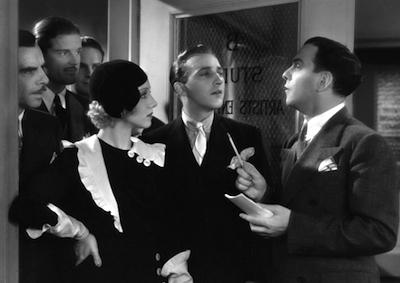In the late 1920s, the talkies introduced a wave of all-star revues, such as MGM’s The Hollywood Revue of 1929 and Warner Bros.’s The Show of Shows (1929), which were inspired by the boisterous spirit of vaudeville. Paramount used this variety format as a vehicle to showcase a dazzling array of radio personalities—15 total—whose stardom was built on coast-to-coast radio programs, record sales and nightclub shows. Radio was in its golden age, and Hollywood had found ways to capitalize on its popularity.
The Big Broadcast stars Bing Crosby in his first major role in a feature. The crooner had made his screen debut in Universal’s King of Jazz (1930) as part of The Rhythm Boys trio. Crosby later signed with Mack Sennett, starring in a string of successful musical comedy shorts. In The Big Broadcast, Crosby portrays a radio heartthrob whose perennial tardiness—caused by Sharon Lynn’s vampy Mona Lowe (a play on the tune “Moanin’ Low”)—leads a sponsor to pull the plug on the WADX station. When Mona jilts him for another man, the inconsolable (and inebriated) Bing enters a suicide pact with newfound friend Leslie (Stuart Erwin), an equally lovelorn Texas oilman. In the sober light of day, Leslie resolves to set things right by buying the radio station and preparing the next big broadcast.
The loose narrative interweaves performances by each of the radio talents, among them the Boswell Sisters, Cab Calloway (who steals the show with “Kickin’ the Gong Around”) and the Mills Brothers. Burns and Allen make their feature film debut as the distressed station manager and his birdbrained stenographer. Director Frank Tuttle, who had been making comedies since the early 1920s, further animates the film by employing a number of delightful camera tricks that harken back to slapstick two-reelers. The film proved to be a hit, prompting Paramount to revisit the variety format with International House (1933) and three more Big Broadcast pictures in the 1930s. —Jennifer Rhee
Director: Frank Tuttle. Production: Paramount Publix Corp. Distribution: Paramount Publix Corp. Screenwriter: George Marion Jr. Based on the play Wild Waves by William Ford. Cinematographer: George Folsey. Cast: Stuart Erwin, Bing Crosby, Leila Hyams, Sharon Lynn, Gracie Allen. 35mm, b/w, 80 min.
Restored by UCLA Film & Television Archive and Universal Pictures from a 35mm acetate composite fine grain master positive and a 35mm nitrate composite print. Laboratory services by The Stanford Theatre Film Laboratory, BluWave Audio. Special thanks to: Bob O’Neil, Michael Feinberg.






 Mobile Navigation
Mobile Navigation

